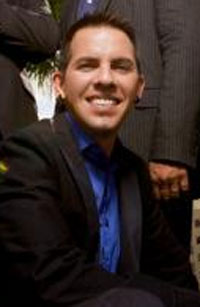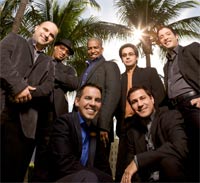Carl Topilow will conduct the CIM Orchestra and Miami timba band Tiempo Libre in Ricardo Lorenz’s ‘Rumba Sinfónica’ on Saturday, October 24 at 8:30 in Severance Hall as part of the CIM Women’s Committee’s annual benefit. Tiempo Libre plays a set of their own after intermission. We reached composer Ricardo Lorenz and pianist and Tiempo Libre music director Jorge Gomez by conference call to talk about the genesis of a work for symphony orchestra and Cuban band.
Daniel Hathaway: I wanted to talk a little bit about the performance next Saturday at Severance Hall. How did this project get started in the first place?

DH: At Indiana University?
Ricardo: Yes. I was teaching there for a couple of years and Jorge came to do master classes. What really caught my imagination is when I saw him doing rumba with music students. I had this idea running in my head, but it had to be put together with somebody like Jorge who brings together his classical background and his jazz and Cuban background.
DH: Jorge, what did you think when Ricardo approached you?
Jorge Gomez: Oh, that was a challenge. He said we have to do something big with classical music. I wasn’t sure what it was going to be.
Ricardo: Until I showed up at his door in Miami. Because he didn’t believe me, and I said, well if this is going to work I’m going to have to jump on a plane and knock on his door in North Miami Beach where he lives, and that’s the way it started. So we worked over three weekends over a period of three months or so, in his apartment. We pretty much jammed an idea I would bring to him and Jorge would return with these very hot Cuban jazz arrangements.
DH: What was that process like, Jorge?
Jorge: Well, we started with an idea, a melody. He brought the melody and we discussed what we’re going to do with that melody. And we understood that we’re going to have a journey with that melody all around the Cuban rhythms — the cha cha cha, the rumba, timba.
Ricardo: And the beer helped!
DH: The beer always helps the inspiration! It was Ricardo who generated the themes?
Ricardo: Yes. To start something like this you have to go back to models because nothing like this existed until we did Rumba Sinfónica. So I thought, because this was going to be played by a symphony orchestra in a concert hall, what model do we have in the classical repertoire? I thought the closest thing we had, even though now it looks really far away from what we did, is Ravel’s ‘Bolero’. I thought for this to work, we have to have a very, very tight, strong melody like the Ravel — not as complicated as that one, but very, very strong. And then instead of just having it travel around different instruments, as Jorge said, we’re going to have it travel around different genres of Cuban music. Jorge was extremely helpful in grabbing the melody I brought and making it sound much more authentic, like rumba. He helped me simplify it, because I came thinking like a composer, and he said, well, look, this works, but if you simplify it, we end up with a jewel. And I think it ended up being something just very tight. And that was good DNA to build all the other variations that came afterwards.
DH: So it took about three months from beginning to end of the composition process?
Ricardo: Well, I went about three times to Miami, and each time we worked really hard — we spent about twenty hours each time I went there. What we ended up was a good map or draft of these variations in a MIDI file. This is something Jorge does very well. He sequences samples on the computer that sound like a band — trumpet sounds and percussion sounds and so on. We did that in real time. As he was inputting, I would say, no, no let’s try this, and we’d listen to the theme again and do whatever. We ended up with something that was a very rough sketch. I brought that back, but it took another four months to create a whole 30 minutes of orchestral music to go along with it.
DH: Jorge, what did you think when you first heard what Ricardo had come up with?

DH: So you were very happy with the result.
Jorge: Yeah! It’s the first time you’re going to see people dancing with a classical symphony.
DH: Who did the first performance?
Ricardo: The Minnesota Orchestra with Tiempo Libre, almost three years ago
DH: And it’s traveled around quite a bit since then?
Ricardo: Yes, and I’ve been chasing these guys — they’re so busy playing in so many different places. Once in a while I show up. But really, now it’s their show. I did my work, now I just stand backstage and listen to the result.
Jorge: Ricardo, we’ve played that piece 22 times, right?
Ricardo: Something like that, with different orchestras all the time, and you know, what has been wonderful to see is that it hasn’t all been professional orchestras. We’ve done it with top orchestras in the US like the Dallas, Detroit and Minnesota, and also with youth symphonies and college orchestras. Symphony Magazine did a story on it, and once the magazine features something, pretty much everybody in the symphony world reads about it.
Jorge: And also Ottawa in Canada.
Ricardo: Yes, with the Center for the Arts Orchestra. Pinchas Zuckerman is the music director there, although he was not the one conducting the Rumba. For me, it’s been an extraordinary process, a transformation. And what I like the most is — and maybe Jorge will have a different take on this — is that somehow, without us really wanting to, because we were only thinking about the music — now that I hear it, I think that we are offering a new idea of community. You never see in another piece what happens here — you never see seven Latin jazz musicians play with an orchestra, and you never see the reactions back and forth. I really think that it goes beyond the music. It really goes to this idea that new communities are created when you do these hybrid projects.
DH: And it doesn’t hurt that Jorge and his colleagues were trained in a conservatory.
Ricardo: No, that was crucial for this to be able to work. The fact that he understands that world, and that I also understand the Cuban world. Even though I’m not Cuban, I grew up with Cuban music, I played in salsa bands. We played something different, but it helps both ways. Otherwise, you can’t meet in the middle, on an equal footing, as opposed to having one style overshadowed by the other.

Jorge: No, just Tiempo Libre (left).
Ricardo: Well, by contract and by level of musicality and understanding of the piece. Tiempo Libre has a three year exclusivity contract.
Jorge: But I would like to see it played by other guys! It would be interesting.
DH: It would change?
Ricardo: Well, it would be a lot of work, and I don’t know if the piece would change or not. In the meantime, it’s Tiempo Libre’s piece.
DH: Jorge, even with Tiempo Libre, does the piece change from performance to performance?
Jorge: Not really, but because we have a lot of improvisation, the trumpet has his solo, I have my solo, so all the time you’re going to have a different solo, but basically it’s the same thing.
DH: Do you have any ideas for working together in the future?
Ricardo: I have many, but these guys are very busy.
Jorge: Sure. We’d like to do something big!
DH: You are both émigrés. How are things in your home countries these days?
Ricardo: I did not appreciate the travesty that Cubans have to go through until I find myself going through the same thing with my country, Venezuela. Because of people who decide that they’re going to simply perpetuate themselves rather than advance the country.
Jorge: It’s very sad that you have to leave your country to follow your dream. The better thing is: do your dream in your country. You’re going to feel more comfortable. Thank God that we have the United States.
Ricardo: I say the same thing. We also came here to contribute, to give back something through this wonderful music. A modest contribution, but I think well worth it.
Jorge: Without this country, ‘Rumba Sinfónica’ would never exist.
Ricardo: That’s the beauty of the US — it’s a laboratory to try creative things. You just have to imagine it and it’s possible. And ‘Rumba Sinfónica’ is a result of that.
For more information about Saturday’s performance, click here.



